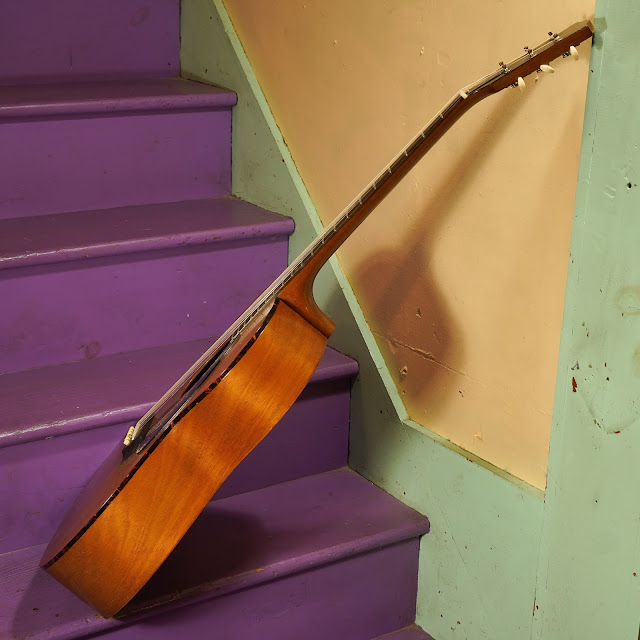1964 Gibson LG-0 Flattop Guitar
LG-0s are fun guitars. My friend Susie plays her Epiphone-branded one (a "Caballero") as her main-and-only and they're a staple for plenty of touring acts and recording studios. They've got a woody, bluesy, rootsy sound that has plenty of kick and clarity. Like a lot of ladder-braced guitars, the sound pops right out front and so they often sound a lot better to the audience than the player.
This one arrived here for consignment in untouched, original condition -- complete with its Gibson chip case and hang tag. It had an original plastic bridge on it, though, which was beginning to wear-out and needed replacing. After that and other work it plays bang-on fast, it's stable, and it sounds great. Dedicated fingerpickers will get the most out of these guitars but flatpickers who don't just thump chords and play in a bit of an old-fashioned style will find them killer for country-blues or rootsy Americana styles.
Being a '64, this guitar still has the wider/bog-standard 1 11/16" nut width rather than the '65-and-up "narrow" nut width which started at 1 5/8" and shrunk a little every year there after approaching 1969.
Repairs included: a neck reset, fret level/dress, replacement rosewood bridge, new bone saddle, some brace regluing, and setup.
Top wood: solid mahogany
Back & sides wood: solid mahogany
Bracing type: ladder
Bridge: rosewood
Fretboard: rosewood
Neck wood: mahogany
Action height at 12th fret: 3/32” bass 1/16” treble (fast, spot-on)
String gauges: 52w, 40w, 30w, 22w, 16, 12 custom set
Neck shape: medium-smaller C
Board radius: ~10-12"
Truss rod: adjustable
Neck relief: straight
Fret style: wide/low
Scale length: 24 5/8"
Nut width: 1 11/16"
Body width: 14 1/4"
Body depth: 4 3/8"
Weight: 3 lbs 11 oz
Condition notes: it's crack-free in the wood though the finish shows plenty of weather-check and hairline "crackle." The bridge is a replacement (in style a lot like a late-'50s Gibson bridge) and is a little larger than the original plastic one, though it's patterned on it. I had to make it longer to cover the original (misplaced) bridge marks. I had to mildly-trim the pickguard's lower edge to fit the new bridge's profile but it's not obvious at all. The saddle is also a replacement but the pins are original. The tuners are original and are slightly fussy but hold just fine. As you might expect, being a ladder-braced guitar the top has some deflection/minor belly behind and under the bridge. It's nothing to worry about and is on every LG-0 and LG-1 I've ever worked-on. The top binding is also split at the waist on the treble side but is glued-pat in position. It's not obvious.
It comes with: its original chip case and hang tags. The original bridge, saddle, and mounting hardware are in the case pocket.



















Comments
I'm curious whether that those parallel model Epiphones and Gibsons had the same width and thickness necks. I always felt both Epiphones were slim and narrow, but that may be because my next four guitars were so different -- a brand-x 12-string and three slotted-head Martins (00-16C, 0-18K and 00-21).